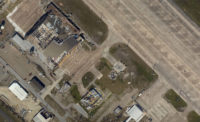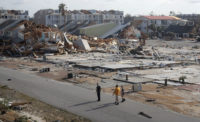Recovery Crews Swing Into Action as Hurricane Michael Departs
Impacts extend from the Gulf Coast to New York

In Florida, a crew with the City of Tallahassee Utilities gets ready to tackle one of the thousands of trees that came down and took out power to 110,000 customers when Hurricane Michael came ashore Oct. 10. Gusts of up to 100 mph swept the city during the storm. Photo courtesy of the City of Tallahassee
By the time the blustery remnants Hurricane Michael departed the East Coast around mid day on Oct. 12, with one last lashing of eastern regions from Virginia to New York, the trail of woe stretched from the Florida Panhandle through the southeastern states and well up the Eastern Seaboard. Authorities report the death toll stood at 16, with victims in Florida, Georgia, North Carolina and Virginia.
As the weekend approached utility repair and debris removal crews mobilized throughout the swath of damage. Catastrophe modeling company Karen Clark Company, Boston projects insured losses will reach $8 billion.
Electric Utilities
In one measure of the impact—and response—at midday Oct. 12 the electric utility infrastructure damage, mostly from high and gusty winds and in terms of customers without power, reached 1.5 million, but repair crews were swinging into action in the storm’s wake and by 4 p.m. that number was down to 1.18-million, according to PowerOutage.US, a website that tracks electric service status, state by state, nationwide.
PowerOutage.US data showed that at 5 p.m. the power loss from Michael remained deep and widespread, including substantial new damage in the Carolinas, where the last service restoration after Hurricane Florence struck a month before, has only recently been completed. Michael’s new toll at 5 p.m.: North Carolina had 339,249 customers without power, Virginia, 336,638; Florida, 270,009; Georgia, 136,144; Alabama, 19,233; New Jersey, 3,400; South Carolina 2,068 and Maryland, 2,034.
Crews from across the U.S. vectored in to the states in most need, which appear to be North Carolina, Georgia and Virginia.
ENR spoke with a lineman from one of those converging crews, who asked not to be named because he was unauthorized to speak about the mobilization, but who said, “They called me last night and said I should pack my bags. We are headed to North Carolina … Florida didn’t need our help; Georgia was going to get our help, but North Carolina put in the bid quicker,” he said.
“It’s pretty torn up so we might end up sending a second set of crews down after the first crews are done … I doubt it … but it’s a possibility,” the lineman said.
A Duke energy spokesperson says, “Weʼre focusing on rebuilding the infrastructure itself because it was deeply damaged. The other issue weʼre running into in Florida is that we have a lot of interconnects with a lot of other municipalities and co-ops.
Critical Infrastructure
In the Florida Panhandle officials and residents were still head-down and focused on search, rescue and critical response issues as they addressed devastation in the areas around where Hurricane Michael came ashore as a Category 4 storm on Oct. 10 with a storm surge as high as 14 ft on the coast.
Storm damage in Florida has forced four hospitals and 11 nursing facilities to close, according to the Federal Emergency Management Agency. Panama City officials are coping with storm impacts at two of its hospitals.
The city’s 69-year-old, 323-bed, Bay Medical Sacred Heart Regional Medical Center suffered damage to a 200,000-sq-ft, five-story patient care tower with 144 private patient rooms that was completed by Hoar Construction LLC. in 2010. The center serves a seven-county region in northwest Florida.
According to an account in The New York Times, as the storm hit, the outer panes of double-paned windows started blowing out on the upper floors of the new tower. About 40 intensive-care patients were moved to safer quarters on lower levels and deeper inside the building.
On Thursday the facility was partially electrified from its own generators, but water was off. Hospital staff tweeted that an exterior wall also has cracked.
The Times further reports that the hurricane damaged the roof and windows of the nearby Gulf Coast Regional Medical Center, which evacuated all of its 130 patients.
The medical center broke ground in January 2017 on a $13.3-million expansion of its the emergency center by 44 private beds. ENR has not determined whether the expansion was completed as scheduled in July.
Federal Response
In a daily press briefing Oct. 12, FEMA Administrator Brock Long said search and rescue teams had finally been able that morning to reach Mexico Beach, the town where the eye came ashore about midday Oct. 10, and had about 50% of the community surveyed by noon.
Long said mobile communications equipment is being moved into the hardest hit area to take some of the load of the damaged cellular tower network.
Long took time to express frustration with “hurricane amnesia,” where people forget lessons of past disasters, don’t follow evacuation orders, nor take steps to prepare their homes and facilities. “You see enough of this in your career, and you get ticked off about it,” he said. Long noted how lessons about storm surge on the Gulf Coast that should have been learned from 2005’s Hurricane Katrina, appear to have been lost when Hurricane Michael approached, in part because the focus after Katrina shifted so strongly to the deaths and damage in New Orleans. Overlooked in the bracing for Hurricane Michael, it seems, was the destruction and 270 deaths attributed to Katrina’s 29-ft storm surge that swept into Mississippi.
“And now we have to repeat it” he said, adding, “I’m afraid we’ll be doing this again in 10 years after people forget the lessons of Mexico Beach.”
Long said that while funding for pre-disaster mitigation in the recently passed FAA reauthorization bill can help, other things such as a revised National Flood Insurance Program and better insurance and mitigation education for property owners would help as well. Also key to resiliency, he said, are building codes at the state and local levels.
In other federal response, the Environmental Protection Administration is continuing to gather data for assessments. It has conducted an aerial survey of regulated sites from Pensacola to Apalachicola and has no reports of major releases of oil and hazardous substances. It also is assessing more than 600 drinking water systems in affected counties but says most appear operational.
The U.S. Army Corps of Engineers reports that it is continuing damage assessments and mission scoping for debris removal in Florida and Georgia. It says most Corps flood risk management projects came through the storm unscathed, although it says two hydroelectric dams in Georgia are damaged, but are operational.





